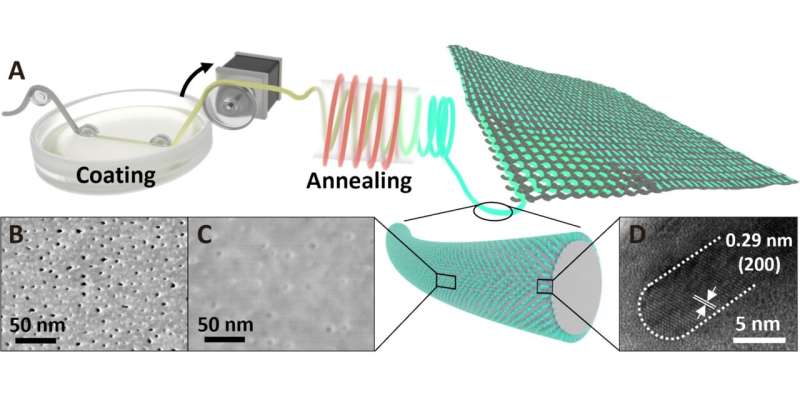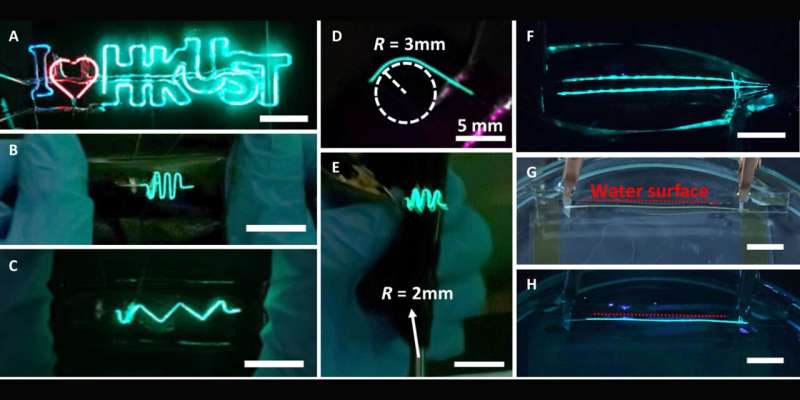This article has been reviewed according to Science X's editorial process and policies. Editors have highlighted the following attributes while ensuring the content's credibility:
fact-checked
peer-reviewed publication
trusted source
proofread
Full-color fiber LEDs created with perovskite quantum wires pave way for advanced wearable displays

A research team led by the School of Engineering of the Hong Kong University of Science and Technology (HKUST) has developed full-color fiber light-emitting diodes utilizing perovskite quantum wires (PeQWs), paving the way for innovative wearable lighting and display devices.
The study is published in the journal Science Advances and titled "Full-color fiber light-emitting diodes based on perovskite quantum wires."
Fiber light-emitting diodes (Fi-LEDs) stand out as a key component in the realm of flexible LEDs because of their compatibility with textile fabrication and excellent spatial luminance uniformity. Metal halide perovskites (MHPs) have emerged as promising light-emitting materials for next-generation LEDs due to their superior optoelectronic properties.
Despite the potential, the fabrication of MHP-based Fi-LEDs has faced challenges such as gravity- and surface tension-induced nonuniform coating, low-quality crystallization, and complex electrode deposition processes, which all culminate in uneven and inefficient light emission.
To tackle these issues, the research team led by Prof. Fan Zhiyong, Chair Professor at HKUST's Department of Electronic & Computer Engineering and Department of Chemical & Biological Engineering, employed a novel approach using porous alumina membrane (PAM) templates on thin aluminum fibers. The PAM, with an ultrasmall pore size of approximately 5 nm, was fabricated on aluminum fibers using a roll-to-roll solution-coating process.

The MHP precursor solution was filled into the PAM channels, followed by a surrounding annealing procedure to ensure spatially uniform solvent vaporization and MHP crystallization. This method enables the uniform growth of PeQW arrays and minimizes the formation of unwanted thin-film structures on the PAM surface.
The research team successfully demonstrated the fabrication of full-color Fi-LEDs with emission peaks at 625 nm (red), 512 nm (green), and 490 nm (sky-blue). The fabricated fibers exhibited good bendability and stretchability, making them suitable for textile lighting applications.
Various 2D and 3D architectures were showcased, including a 2D full-color string "I ♥ HKUST," all with excellent fluorescence uniformity. Additionally, a "night scene" of Victoria Harbor was created using PeQWs with halide gradient-induced color transitions, highlighting the versatility and aesthetic potential of the Fi-LEDs.
This work presents a significant advancement in the field of Fi-LEDs. Future developments could focus on enhancing the efficiency and stability of the Fi-LEDs, exploring new perovskite compositions for a broader range of emission colors, and integrating these devices into commercial textile products.

"The combination of quantum confinement effect and the passivation from the 3D porous alumina membrane structure has enabled us to achieve outstanding photoluminescence and electroluminescence efficacy. Our innovative approach for fiber LEDs opens up new possibilities for fabricating unconventional 3D-structured lighting sources, paving the way for advanced wearable display technologies," said Prof. Fan.
Electronic and Computer Engineering Ph.D. student Ren Beitao is the first author, and Prof. Fan is the corresponding author. Other co-authors include Ph.D. students and postdoc researchers in Prof. Fan's group and collaborators in Sun Yat-sen University and Nanjing University of Science and Technology.
More information: Beitao Ren et al, Full-color fiber light-emitting diodes based on perovskite quantum wires, Science Advances (2024). DOI: 10.1126/sciadv.adn1095




















